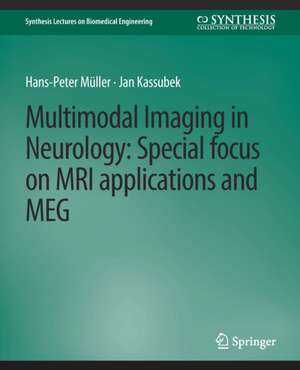Multimodal Imaging in Neurology: Special Focus on MRI Applications and MEG: Synthesis Lectures on Biomedical Engineering
Autor Hans-Peter Müller, Jan Kassubeken Limba Engleză Paperback – 31 dec 2007
Din seria Synthesis Lectures on Biomedical Engineering
- 17%
 Preț: 362.03 lei
Preț: 362.03 lei - 15%
 Preț: 522.24 lei
Preț: 522.24 lei - 5%
 Preț: 364.74 lei
Preț: 364.74 lei - 5%
 Preț: 525.89 lei
Preț: 525.89 lei - 15%
 Preț: 636.80 lei
Preț: 636.80 lei -
 Preț: 382.95 lei
Preț: 382.95 lei -
 Preț: 268.83 lei
Preț: 268.83 lei -
 Preț: 260.77 lei
Preț: 260.77 lei -
 Preț: 266.32 lei
Preț: 266.32 lei -
 Preț: 265.18 lei
Preț: 265.18 lei -
 Preț: 262.47 lei
Preț: 262.47 lei -
 Preț: 204.76 lei
Preț: 204.76 lei -
 Preț: 268.66 lei
Preț: 268.66 lei -
 Preț: 262.47 lei
Preț: 262.47 lei -
 Preț: 206.84 lei
Preț: 206.84 lei -
 Preț: 321.54 lei
Preț: 321.54 lei -
 Preț: 192.05 lei
Preț: 192.05 lei -
 Preț: 261.32 lei
Preț: 261.32 lei -
 Preț: 261.53 lei
Preț: 261.53 lei -
 Preț: 206.84 lei
Preț: 206.84 lei -
 Preț: 349.36 lei
Preț: 349.36 lei -
 Preț: 260.95 lei
Preț: 260.95 lei -
 Preț: 204.76 lei
Preț: 204.76 lei -
 Preț: 391.02 lei
Preț: 391.02 lei -
 Preț: 268.83 lei
Preț: 268.83 lei -
 Preț: 205.92 lei
Preț: 205.92 lei -
 Preț: 382.57 lei
Preț: 382.57 lei -
 Preț: 346.48 lei
Preț: 346.48 lei -
 Preț: 264.41 lei
Preț: 264.41 lei -
 Preț: 384.48 lei
Preț: 384.48 lei -
 Preț: 259.04 lei
Preț: 259.04 lei -
 Preț: 260.95 lei
Preț: 260.95 lei -
 Preț: 261.32 lei
Preț: 261.32 lei -
 Preț: 158.66 lei
Preț: 158.66 lei -
 Preț: 267.86 lei
Preț: 267.86 lei -
 Preț: 207.65 lei
Preț: 207.65 lei -
 Preț: 205.92 lei
Preț: 205.92 lei -
 Preț: 268.66 lei
Preț: 268.66 lei -
 Preț: 322.31 lei
Preț: 322.31 lei -
 Preț: 205.70 lei
Preț: 205.70 lei -
 Preț: 226.22 lei
Preț: 226.22 lei - 15%
 Preț: 404.48 lei
Preț: 404.48 lei -
 Preț: 263.28 lei
Preț: 263.28 lei -
 Preț: 383.71 lei
Preț: 383.71 lei -
 Preț: 273.45 lei
Preț: 273.45 lei -
 Preț: 207.06 lei
Preț: 207.06 lei -
 Preț: 263.06 lei
Preț: 263.06 lei -
 Preț: 260.77 lei
Preț: 260.77 lei -
 Preț: 205.33 lei
Preț: 205.33 lei
Preț: 206.29 lei
Nou
Puncte Express: 309
Preț estimativ în valută:
39.47€ • 43.01$ • 33.26£
39.47€ • 43.01$ • 33.26£
Carte tipărită la comandă
Livrare economică 24 aprilie-08 mai
Preluare comenzi: 021 569.72.76
Specificații
ISBN-13: 9783031004957
ISBN-10: 3031004957
Ilustrații: X, 75 p.
Dimensiuni: 191 x 235 mm
Greutate: 0.17 kg
Editura: Springer International Publishing
Colecția Springer
Seria Synthesis Lectures on Biomedical Engineering
Locul publicării:Cham, Switzerland
ISBN-10: 3031004957
Ilustrații: X, 75 p.
Dimensiuni: 191 x 235 mm
Greutate: 0.17 kg
Editura: Springer International Publishing
Colecția Springer
Seria Synthesis Lectures on Biomedical Engineering
Locul publicării:Cham, Switzerland
Cuprins
Introduction.- Neurological Measurement Techniques and First Steps of Postprocessing.- Coordinate Transformation.- Examples for Multimodal Imaging.- Clinical Aspects of Multimodal Imaging.- References.- Biography.
Notă biografică
Dr. rer. nat. Hans-Peter Müller is currently working as researcher at the Department of Neurology, University of Ulm, Germany. He formerly worked at Central Institute for Biomedical Engineering, University of Ulm, Germany and at Physikalisch-Technische Bundesanstalt, Berlin, Germany. He finished his Ph.D. in 1996 in magnetic resonance microscopy. Main areas of interest include software development for magnetic resonance imaging (diffusion tensor imaging as well as functional magnetic resonance imaging) and magnetoencephalography. Prof. Dr. med. Jan Kassubek is currently working as senior clinician and researcher at the Depart[1]ment of Neurology, University of Ulm, Germany and has the position as the Vice Chairman. He finished his M.D. in 1997. He formerly worked as Medical Doctor/Researcher at the Division of Experimental Neuropsychiatry, Department of Neurology, University of Erlangen, Germany, then at the Center for Magnetic Resonance Research, University of Minnesota Medical School, Min[1]neapolis, MN, USA, and at the Department of Neurology, University of Freiburg, Germany. Main areas of interest are clinical research on neuroimaging, in particular magnetic resonance imaging and magnetoencephalography, with a focus on neurodegenerative diseases.
